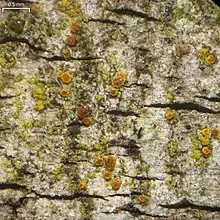Piccolia nannaria
Piccolia nannaria is a species of crustose lichen in the class Lecanoromycetes.[2] It is widespread but uncommon in the coastal plain of southeastern North America. Initially thought to be corticolous (bark-dwelling), later collection of the lichen suggest that it may be lichenicolous (lichen-dwelling).
| Piccolia nannaria | |
|---|---|
 | |
| scale bar = 0.5 mm | |
| Scientific classification | |
| Domain: | Eukaryota |
| Kingdom: | Fungi |
| Division: | Ascomycota |
| Class: | Lecanoromycetes |
| Order: | incertae sedis |
| Family: | incertae sedis |
| Genus: | Piccolia |
| Species: | P. nannaria |
| Binomial name | |
| Piccolia nannaria (Tuck.) Lendemer & Beeching (2007) | |
| Synonyms[1] | |
| |
Taxonomy
The species was first formally described as a new species in 1872 by American lichenologist Edward Tuckerman, as Heterothecium nannarium. The type specimen was collected by Charles Wright in Texas in 1850.[3] Alexander Zahlbruckner proposed a transfer to the genus Biatorella in 1927. James Lendemer and Sean Beeching transferred the taxon to the genus Piccolia in 2007.[4]
Description
Piccolia nannaria is characterized by its granular and leprose yellow exterior or thallus. Its apothecia, which range in colour from a subtle green to an orange-yellow, are quite tiny, and its asci are polysporous, housing numerous minuscule spherical, colourless ascospores.[4]
Distribution and ecology
The lichen is widespread but uncommon in the coastal plain of southeastern North America, south to Georgia.[5] Its range was later extended after it was recorded as far north as Maryland. In the Delmarva Peninsula, several populations were discovered where the lichen had numerous pycnidia (not previously reported in this species), but lacked apothecia. Although the lichen was previously assumed to be corticolous (bark-dwelling), further collections and additional investigation of previously collected specimens suggests that the species may be lichenicolous (lichen-dwelling), as it appears to be consistently associated and growing over the crustose lichen Pyrrhospora varians, sometimes to the point almost almost completely obscuring the thallus of its putative host. Additional research is needed to firmly establish the ecological preferences of this lichen.[4]
References
- "Synonymy. Current Name: Piccolia nannaria (Tuck.) Lendemer & Beeching, in Knudsen & Lendemer, Mycotaxon 101: 83 (2007)". Species Fungorum. Retrieved 28 March 2023.
- "Piccolia nannaria (Tuck.) Lendemer & Beeching". Catalogue of Life. Species 2000: Leiden, the Netherlands. Retrieved 12 June 2023.
- Tuckerman, E. (1872). Genera Lichenum: An arrangement of the North America lichens. Amherst: E. Nelson. p. 176.
- Lendemer, James; Harris, Richard C. (2014). "Studies in lichens and lichenicolous fungi – No. 19: Further notes on species from the Coastal Plain of southeastern North America". Opuscula Philolichenum. 13: 155–176.
- Knudsen, K.; Lendemer, J.C. (2007). "Studies in lichens and lichenicolous fungi: Notes on some North American taxa". Mycotaxon. 101: 81–87.